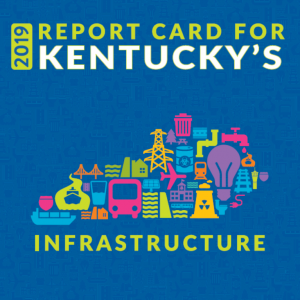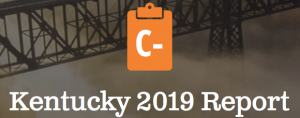The Kentucky Section of the American Society of Civil Engineers (ASCE) has released the 2019 Report Card for Kentucky’s Infrastructure, giving 10 categories of infrastructure an overall grade of “C-.”
Kentucky civil engineers examined the state’s aviation, bridges, dams, drinking water, energy, hazardous waste, levees, roads, solid waste and wastewater.
The report evaluated the 10 categories with the following grades: aviation (C+), bridges (C-), dams (D+), drinking water (C+), energy (B-), hazardous waste (D), levees (D+), roads (D+), solid waste (B-) and wastewater (C-).
The Kentucky surface transportation categories, roads and bridges, saw slight increases in the report. Bridges and roads received a “C-” and “D+,” respectively.
The Kentucky Transportation Cabinet (KYTC) recently instituted the Bridging Kentucky program, which will restore more than 1,000 state, county and municipal bridges across Kentucky’s 120 counties between 2018 and 2024. These repairs will add at least 30 years of life to most of these bridges, and construction for bridge replacement would provide at least 75 years of useful life.
Kentucky has already made some incremental progress in reducing the number of structurally deficient bridges throughout the state. In 2011, nearly 9.25 percent of all bridges in Kentucky were structurally deficient; by 2017, 7.77 percent were structurally deficient.
Kentucky’s rural communities require significant funding to ensure their residents have access to clean drinking water and to address existing aging water and wastewater infrastructure systems. Even though Kentucky’s water service level is one of the highest in the United States, more than an estimated 100,000 residents are still without access to a public drinking water supply.
In 2011, the Environmental Protection Agency Drinking Water Infrastructure Needs Survey and Assessment reported a $6.2 billion funding need for Kentucky’s drinking water infrastructure.
The updated 2018 assessment (using 2016 survey data) reports an estimated 20-year funding need of $8.2 billion for Kentucky, which represents a 32 percent increase over 2011. Additionally, access to wastewater treatment facilities is a significant issue for many Kentucky communities.
For example, some of the pipelines that send wastewater to treatment plants are more than 70 years old. Additionally, 40 percent of Kentuckians do not have access to water treatment plants, relying on septic tanks or other private systems, the condition of which is generally unknown.
“This Report Card demonstrates the critical need to invest more in our water infrastructure, particularly in smaller systems that serve our many rural communities across the state,” said Peter Goodmann, Director, Division of Water, Kentucky Department of Environmental Protection. “We need to be paying more attention to the needs of our residents by continuing to update the 20-year drinking water and wastewater infrastructure needs assessments at least every three to five years.”
Hazardous waste, which is defined as any liquid, solid, contained gas or sludge that pose a serious threat to human health and environment, earned one of the lowest grades, sitting at a “D.”
This grade decreased from the “C” in 2011. Three thousand entities are generating hazardous waste in Kentucky. The top generators of hazardous waste in Kentucky are chemical, metal and plastic manufacturing facilities, and the latest data on record shows that Kentucky generated 146,779 tons of this type of waste in 2016.
Kentucky projected $1.6 billion in remedial costs, and there are hundreds of old or abandoned waste sites that still pose threats to the environment and public health.
“We should not be particularly proud of this Report Card,” said Tom Rockaway, Chair, Kentucky Report Card Committee. “The good news is that our state leaders are not only prioritizing infrastructure in need of repair and replacement, but also planning strategically for the future. Adequate investment and proper planning will provide safe and healthy environments for our children, neighbors and communities.”
Other notable findings in the report include:
•Kentucky airports have a total economic impact of nearly $15 billion annually, yielding nearly 115,000 jobs. Cincinnati/Northern Kentucky and Louisville International Airports account for more than 83 percent, or approximately $12.5 billion, of the total economic impact annually.
•The current operating budget for the Dam Safety section of the Division of Water is $529,490 annually, which is one-third of the budget eight years ago.
•All of Kentucky’s levees are protecting more than 306,000 lives and $46.6 billion in property, including hospitals; universities; major manufacturing facilities; critical utilities such as electric power, water and wastewater plants and densely populated metropolitan areas.
•KYTC recently identified $6 billion in unfunded construction projects, which would require an additional $490 million per year to address.
The Report Card also offers solutions to address the state’s infrastructure needs and raise Kentucky’s grade. Recommendations from civil engineers include, but are not limited to, the following:
•Prioritize investment in the state’s infrastructure even during tight budget cycles by strategically working together with state legislators, agencies, municipalities, business owners, citizens and subject matter experts.
•Invest in Kentucky’s multimodal freight network to retain the state’s competitive advantage while preparing for future growth and changes and provide robust investment for intermodal connections and bottlenecks in the network.
•Increase the Passenger Facility Charge (PFC) cap, which would help Kentucky airports access additional capital to support and improve the state’s aviation infrastructure.
•Support the submitted highway investment SHIFT formula used in the development of the six-year 2018 Highway Plan and determine sustainable, long-term funding to fully address the deficiencies that remain in the state’s transportation network.
•Coordinate with rural communities on finding viable funding, which will allow them to invest in critical infrastructure even with a limited population from which to generate revenue.
The Kentucky Report Card was created as a public service to Kentucky residents and policymakers to inform them of the infrastructure challenges and needs in their communities. Civil engineers used their expertise and school report card letter grades to condense complicated data into a readable analysis of Kentucky’s infrastructure network.
ASCE State Infrastructure Report Cards are modeled after the national Infrastructure Report Card, which gave America’s infrastructure a grade of “D+” in 2017.
A full copy of the 2019 Report Card for Kentucky’s Infrastructure Report Card is available at www.InfrastructureReportCard.org/Kentucky.
For more information, about the American Society of Civil Engineers, click here.
American Society of Civil Engineers























